Post contributed by Michelle Wolfson, the 2022-2023 Josiah Charles Trent History of Medicine Intern.
Tell us a little bit about yourself.
I am currently studying library science at East Carolina University. I started the program after realizing both of my children would be in school, in-person (the youngest did kindergarten virtually!), and I could get back to work. I enjoyed being a homemaker for nearly a decade; my children are 10 and 8 years old. Instead of returning completely to work, I decided that I did not want my children to one day say about me, “She really wanted to be a librarian but she never did it,” and so I started at ECU’s online, asynchronous program. I currently work part-time at a public library, as well as here at Duke, and it has been so exciting for me to experience both public and academic librarianship, to see how they differ and overlap. At the public library, I work on the youth services side. I have worked for nearly a year to have our public library system become the first in North Carolina to be sensory inclusive certified and have created a sensory room at one of our branches.
What do you finding interesting about working in libraries, and specifically, the History of Medicine Collections?
What I find most interesting about working in libraries is that everybody is on their own learning journey, and I am thrilled when I can be a part of that or helpful in any way. Working with the History of Medicine Collections is especially exciting because whether I am working with medical students or other students, health and medicine affects all of us, and everybody can find something that is relevant and interesting. Regarding the materials, I most like seeing the ways that people from the past got things right or got things extremely wrong (but you can also see why they thought the way that they did). It makes you appreciate that we’re all in this together, trying to muddle our way through, learning and growing from those before us.
What is a memorable experience from your internship?
There have been so many memorable experiences! I really enjoyed when the family and friends of Dr. Richard Payne came into Rubenstein Library to look over some of his things that are part of the Richard Payne papers 1980-2020. There was so much joy and so many stories everybody shared about Dr. Payne that were sparked when they viewed the collection. And they were excited to hear about how his papers would be used to help educate students, future doctors, and scholars. I also enjoyed being able to introduce primary sources to students in Dr. Seth LeJacq’s Writing 101 class. Seth is a fantastic teacher who also taught me, how to be the kind of thoughtful and purposeful teacher I would like to be when engaging with students. Working with Rachel Ingold, the curator, has also taught me some of the same lessons as Seth – being kind and curious is an invitation to students to learn from you while also teaching you things.
Do you have a favorite item you’d like to share?
I’ve been asked to share a memorable experience and a favorite item! I will share two things. I was asked to look over the Four Seasons for an upcoming digitization project the Digital Production Center (DPC) will be working on in the future. I had the task of counting the flaps to help ensure they are all photographed. I enjoyed that I was able to help a bigger team that will connect more people worldwide to the Four Seasons. It’s a genuinely unique and beautiful item, and who doesn’t love flaps? I also enjoyed seeing the many items that were on display at the annual Anatomy Day. Not only were the items themselves each incredibly interesting, but I also felt great joy at seeing the first-year medical students connect with the items and the history of medicine. So many students immediately flocked to a table that included Japanese medical manuscript notebooks from the early 19th century. These manuscripts include colorful hand-drawn illustrations and are a wonderful example of the advancements medicine can make when ideas are shared globally, as Japanese medical practice at the time was already influenced by Chinese, Portuguese, and Dutch medical practices. The entire event was a gorgeous fusion of medicine and art with examples from Leonardo da Vinci and Vesalius and more, with illustrations in pencil to watercolor, ranging from medicinal plants to anatomical theaters.


